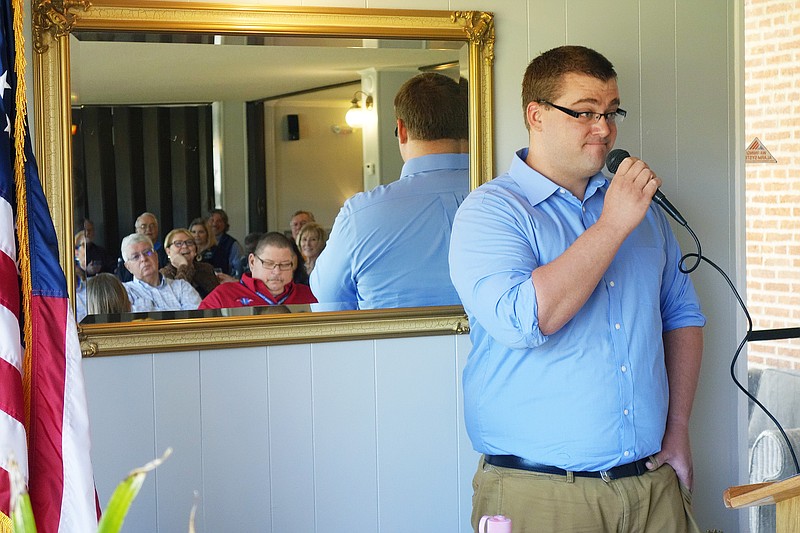Imagine surviving a devastating hurricane on an isolated island. Then imagine not being able to tell your loved ones you are alive.
Now, imagine your loved ones also went through a different hurricane a week before, and you didn’t know if they survived.
That description was reality for the residents of Puerto Rico, according to a Holts Summit man who just returned from there. The island, an American territory in the Caribbean, was devastated by Hurricane Maria on Sept. 20. The American Red Cross — and other volunteers from around the world — responded immediately.
Taking time off from his employment search was Holts Summit resident Justin Perkins, who first went to Houston to help with Hurricane Harvey relief, then spent three weeks in Puerto Rico helping people communicate.
He visited with members of the Fulton Rotary this week, along with ARC disaster program manager Kath Mayne, who went to Florida twice after Hurricane Irma.
Maria hit Puerto Rico on Sept. 20 at 155 mph. Nearly every structure on the island of Dominica was damaged or destroyed. Puerto Rico’s electrical grid failed, and all 3.4 million residents were without power — the largest outage in U.S. history, CNN reported. Most of the island is still without power.
Although he went to Houston to help those victims, it was his trip to the island Perkins discussed with the Fulton organization.
Helping out in Texas and Florida was relatively easy, Perkins said. Supplies could be driven there. That wasn’t so easy for Puerto Rico, which requires a 1,150-air mile flight.
“It’s an island; so it’s hard to get resources there,” Perkins said. “Getting crews there in the first place is difficult.”
Then there’s the terrain.
“What I saw was the mountains,” he said. “(Maria) was a Category 4 hurricane there, and all the roads were washed out.”
Some travel was possible on the outer ring of the island, Perkins said, but going into the steep mountains was hazardous. The highest elevation in Puerto Rico, Cerro de Punta, is 4,390 feet. The island is 100 miles long by 35 miles wide, close to the size of Connecticut. It was covered with debris.
“This made delivering services very, very difficult,” he said.
Some mountain residents hadn’t yet communicated with the outside world when Perkins arrived. He spent three weeks going to a different village each day, sometimes a difficult three-hour trip. He traveled with other ARC volunteers from places such as Spain and Argentina.
They set up satellite dishes and cellphone charging stations, helping people tell their families they were alive.
“In one case, there was a woman who broke out in tears,” Perkins said. “We got her on a Skype phone to her son in Florida, which had also just had a hurricane. They were able to tell each other they were all right.”
The satellites furnished by the American Red Cross wouldn’t work in Puerto Rico, so they got different equipment from the International Red Cross. Much of the island’s cellular service was down, but people wanted to charge their devices in case access came back.
“We set up charging stations,” Perkins said. “They were always full.”
There was no electricity in the mountains — or just about anywhere — but some businesses had generators. Perkins said he remembers pharmacies keeping medications refrigerated by running generators.
“This was five, six weeks after the disaster,” he added.
Perkins arrived in Puerto Rico on Oct. 15 and only recently returned.
“I specifically did the satellite programs; I was glorified tech support all the time,” he said.
Volunteers went door-to-door asking people if they needed to make a phone call or other help.
“Some people hadn’t been out,” he said.
Other lucky people had a mode of transportation.
“There were horses all around, in front yards and backyards, and people were riding them.”
Perkins and his new Red Cross friends often stayed in dormitories at the University of San Juan. Other times, they slept in villages. Warehouses there were full of relief items, but delivering them to where they were needed was another matter.
“I saw helicopters and (airplanes) flying daily, but it was hard to get out the call for help,” he said.
People were appreciative, he added.
“Going out into the cities was cool,” Perkins said. “There was a lot less bitterness there, then I thought (about) why it took so long to get there.”
Mayne said in Florida she helped in Gainesville and the Keys, where homes built post-Hurricane Andrew (1992) mostly withstood the wrath of Irma.
Back home, local Red Cross workers and volunteers make sure their disaster teams are ready to respond to immediate crisis. They do a lot of work with victims of house fires, Mayne said.
“We can’t prevent (disaster), but we have a visceral understanding it can happen,” she added.
Mayne works with the Central and North Missouri chapter of the ARC, based in Jefferson City. She is looking for volunteers. To learn more, contact [email protected] or 573-635-1132.

